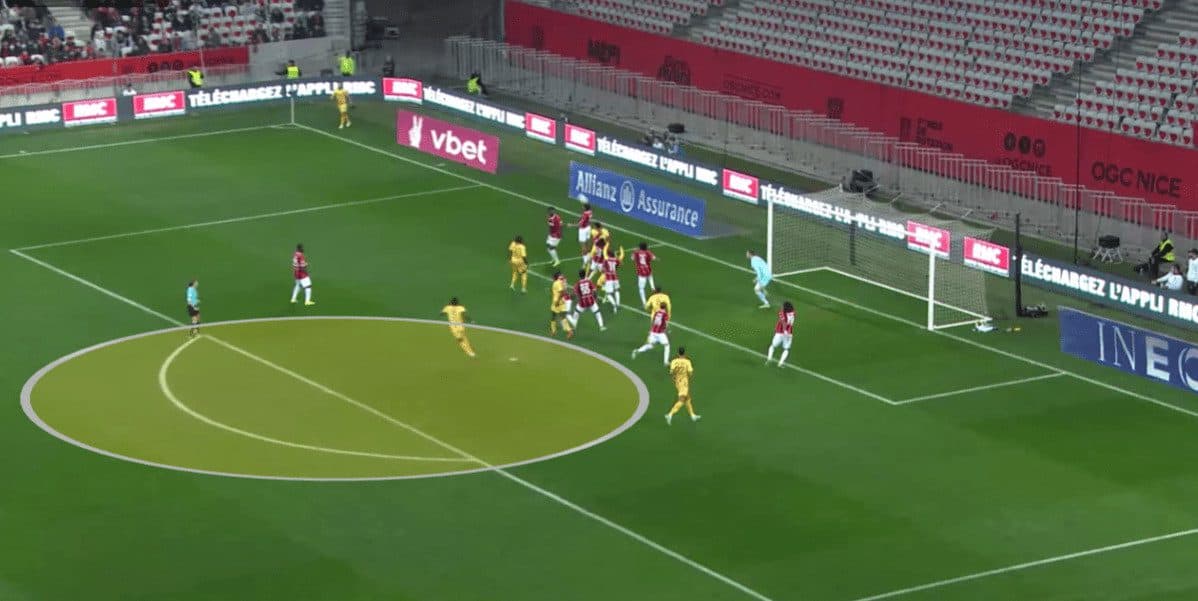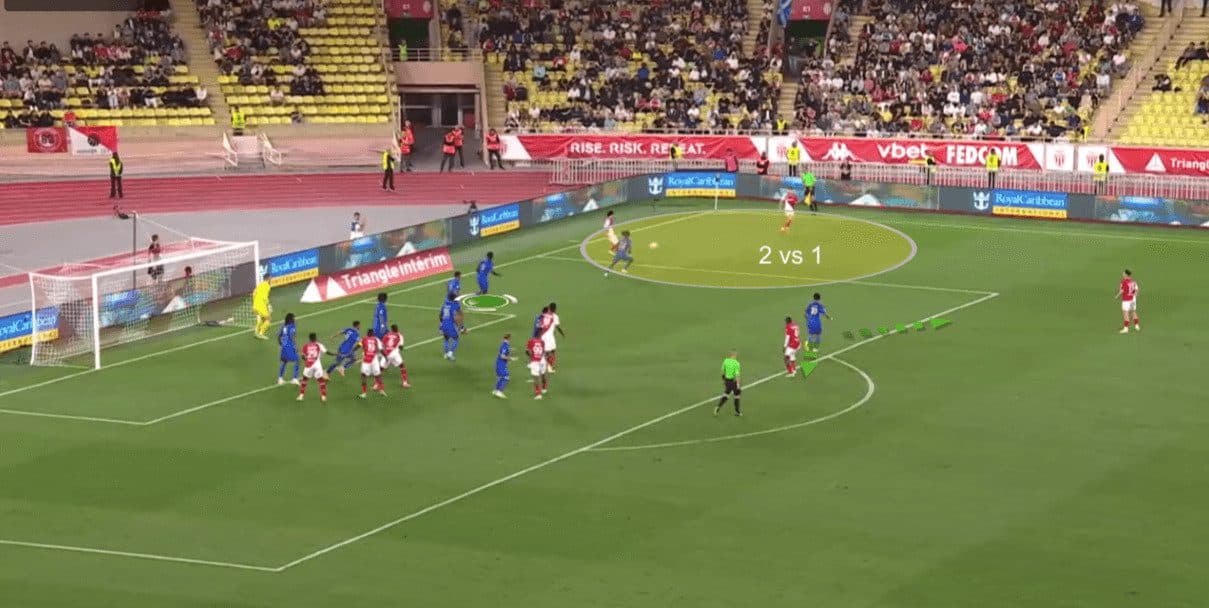OGC Nice occupy the sixth position in the Ligue 1 with 40 points after 25 matches, having won 11 matches, drawn seven, and lost seven.
The competition intensifies this season in Ligue 1 as Nice trail Brest, the team in the second position, by only six points.
The competition is fierce in these ranks, with PSG leading the table on 56 points in the first position so far.
On the offensive front, Nice is struggling significantly compared to their competitors, as they are considered the fourth weakest defensive line in the league, having scored only 24 goals, averaging 0.96 goals per match.
To illustrate the team’s scoring problem, it is noteworthy that Marseille, currently in one position after them in seventh place, have scored 40 goals.
However, defensively, they boast the best defensive line in the league alongside Brest, the team in second place, having conceded only 19.
One of the significant factors contributing to this formidable defence is their prowess in defending set pieces.
They have conceded only a single goal from set pieces, making them the team with the fewest goals conceded from set pieces in the league.
They are the team with the lowest expected goals (xG) conceded from set pieces in the Ligue 1, with a value of 4.04.
Upon closer examination, it becomes evident that their proficiency in defending corner kicks is one of the key factors behind their defensive superiority.
In this tactical analysis, we will discuss Nice’s defensive scheme during corner kicks and the varied tactics implemented by Francesco Farioli in different scenarios.
Also, we will explain the weaknesses that opponents can exploit.
OGC Nice defending Formation
We’ll start by dissecting their defending scheme in corners, knowing why they are so good at protecting their goal at corners and their strengths.
Then, we will go to their weaknesses that opponents can exploit.
In the photo below, they are shown defending with a hybrid system involving four zonal defenders, four man markers, a short-option defender, and a rebound defender.

Sometimes, they dispense with the last zonal defenders, leaving only three zonal defenders to increase man markers, as shown below.

Continuing with their defence scheme, we should mention one of the most critical factors in their defending scheme, which is using their goalkeeper to claim any cross going through the six-yard to the middle of the far post, especially when they defend with only three zonal defenders dispensing of the last zonal defender.
The impressive thing is that he can catch the ball well, not only punch it into dangerous areas inside the box or to the edge of the box, as shown in the two photos below.


Strengths Of This Hybrid Defensive Formation
This hybrid system gives them a balance between zonal and man-marking defending systems, giving them most of the advantages of the two systems.
You can imagine that the opponents’ best four attackers are marked with man markers while guarding the six-yard with four zonal defenders, so if one of the attackers can escape from his marker or outperform him, he will find a zonal player in the valuable areas.
This scheme needs an integrated corner and rigorous system, not only a single idea because you need to escape from man markers and find a way to remove the zonal marker in the targeted area using blocks or other methods.
For example, in the case below, the opponent tries to target the area in front of the first zonal defenders by two players in green and black, while the red attackers come from the back to target the area that the two zonal defenders may leave to chase the ball.

The three attackers are marked by man markers, while the red player got rid of his marker by using his free mate inside the six-yard as a screen.
This sounds like a good idea, but let’s know if that is enough!

In the circle below, the two attackers come with their two-man markers in addition to the first two zonal defenders, so you can see in the targeted area four defenders against two attackers.
This makes it difficult for the attacking team to get the first touch and control the heading well.
If the ball went to the free attacker behind them, he would face the third zonal defender, highlighted in white.

This puts the opponent in two possibilities: either not aiming for a distant area, and in that case, it isn’t easy to convert the header directly into a goal or attempt to target areas close to the six-yard.
In case of success in obtaining the first touch, the attacker loses control of the ball and won’t be able to strike it with power, making it an easy grab for the goalkeeper, as depicted in the two consecutive photos below.


Weaknesses Of This Hybrid Defensive Formation
One of their weaknesses is that their rebound zone defenders can easily be dragged into the box, acting more as a man marker, especially when an attacker runs from the edge to the box to the box.


The result is that the rebound zone is empty now, which could be targeted directly or after short passes, as we will explain later.

It becomes more clear when the attacking team puts a close short-option attacker, forcing the short-option defender to get nearer, leaving this gap shown below, which can be targeted directly with a grounded or high cross.
We also suggest that the green attacker blocks the marker of the white targeted player who comes from the far post in a curved run, which is called a screen, as shown in the two photos below.


If the rebound zone is still standing, cutting this flat passing lane, we can ask a player to run a decoy in front of him to drag him a little to open the passing lane to the white attacker, shown below.

The second point we will discuss is the gap between the second and third zonal players, which occurs when the first one who goes to defend flicks on the corner point of the six-yard line, and the second one moves forward behind him, increasing the distance between the second and third zonal defenders.

In the photo below, you can find the large distance between the first two zonal defenders, in green, and the third zonal one, in white, which two attackers target, so if one could touch the ball or use a mate as a screen to escape from his marker, it would be dangerous.

To prevent this gap, the third defender sometimes shifts more to the near post, especially when he sees a free attacker targeting this gap.
This is a common problem in Nice, where the zonal defender can easily be dragged, with the free attacker acting more as a man marker.
This shifting causes a gap between the third and fourth zonal defenders, as in the second photo below.


This free-attacker problem isn’t only with the third zonal defender; you can also find it with the last zonal defender below, which gives another attacker an opportunity to target this area, as shown in the two following photos.


The last point we will talk about is the ability to implement effective short-corner routines against them.
You can find below that the opponent uses six attackers inside the box trying to drag the rebound defender to act as a marker, so they now only have the short-option defender to cover the short and the rebound areas.
The opponent leaves the short area empty, asking the targeted player to start as a rebound player and then go suddenly to the corner of the box.

He receives the ball in a large area and shoots an easy shot, but it goes above the crossbar.

Monaco used a different short-corner routine by asking a player to come from the six-yard suddenly to receive the ball from the taker to be in a quick 2-v-1 situation against the short-option defender because of the late help of the first zonal defender.

The important trick is preventing the rebound defender from going to help because he has two players to defend against, as shown in the green arrows below.

The second part of the plan is targeting the far post behind the last zonal defender by a free attacker by asking the marked attackers to go to the near post.

PSG tried to target the rebound zone with many short passes to end at the rebound area by using numerical superiority over the two players of Nice, the rebound defender and the short-option defender.

But these passes aren’t enough, as shown in the second photo below, because the rebound defender was intelligent enough to wait in his area, or let’s say that he didn’t rush to press staying in a middle area between the two rebounds attackers, so he could close the option of shooting.
They needed to use some rotations between their players to exploit this numerical superiority and force the rebound defender to press inside the box to empty the rebound area, so we suggest these two movements, shown blue in green, to make the direct pass, in blue, to the rebound attacker more effective.


Conclusion
In this analysis, we have explained the scheme of the best set-piece defending team in France showing how Nice could make a balance between zonal marking and man-marking defending systems to achieve the advantages of the hybrid system.
In this set-piece analysis, we also discuss their weaknesses and how to attack them, exploiting the fact that the rebound defender can be dragged easily out of the rebound zone.
We show how opponents can use short corners to attack them, and we describe the problem of shifting zonal players, leaving gaps between them.






Comments